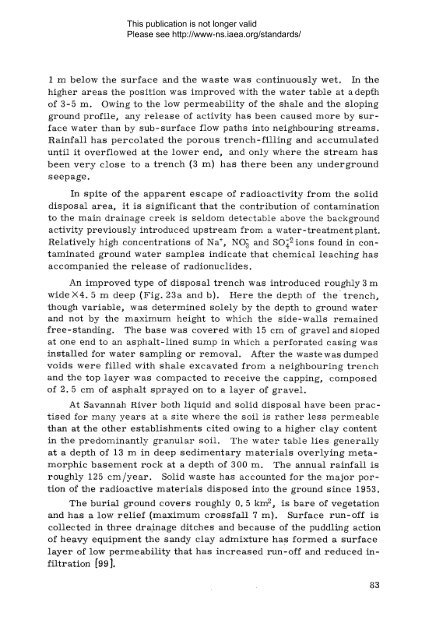Safety_Series_015_1965 - gnssn - International Atomic Energy ...
Safety_Series_015_1965 - gnssn - International Atomic Energy ...
Safety_Series_015_1965 - gnssn - International Atomic Energy ...
You also want an ePaper? Increase the reach of your titles
YUMPU automatically turns print PDFs into web optimized ePapers that Google loves.
This publication is not longer validPlease see http://www-ns.iaea.org/standards/1 m below the su rfa ce and the w aste was continuously w et. In thehigher areas the position was im proved with the water table at a depthof 3-5 m. Owing to the low perm eability of the shale and the slopingground p rofile, any relea se of activity has been caused m ore by su rface water than by su b-su rface flow paths into neighbouring stream s.R ainfall has p erco la te d the p orou s tr e n ch -fillin g and accu m u lateduntil it overflow ed at the low er end, and only where the stream hasbeen v e ry c lo s e to a tren ch (3 m ) has th ere been any undergroundseepage.In spite of the apparent esca p e of ra d ioa ctivity fro m the soliddisposal area, it is significant that the contribution of contaminationto the main drainage creek is seldom detectable above the backgroundactivity previously introduced upstream from a water-treatm entplant.R elatively high concentrations of Na+, NOg and S O ^ions found in contaminatedground water sam ples indicate that ch em ical leaching hasaccom panied the relea se of radion u clides.An im proved type of disposal trench was introduced roughly 3 mw id eX 4 . 5 m deep (F ig. 23a and b). H ere the depth o f the tren ch ,though variable, was determ ined solely by the depth to ground waterand not by the maximum height to which the sid e-w alls rem ainedfree-standing. The base was covered with 15 cm of gravel and slopedat one end to an asphalt-lined sump in which a perforated casing wasinstalled for water sampling or rem oval. After the waste was dumpedvoid s w ere fille d with shale excavated fro m a neigh bou rin g tren chand the top la y er was com pacted to rece iv e the capping, com p osedo f 2. 5 cm o f asphalt sprayed on to a la y er of gravel.At Savannah R iver both liquid and solid disposal have been p ra ctised for many years at a site where the soil is rather less perm eablethan at the other establishm ents cited owing to a higher clay contentin the predom inantly granular soil. The w ater table lie s gen erallyat a depth o f 13 m in deep sed im en tary m a teria ls o v e rly in g m eta -m orphic basem ent rock at a depth o f 300 m. The annual rain fall isroughly 125 cm /y e a r. Solid waste has accounted fo r the m ajor p o rtion of the radioactive m aterials disposed into the ground since 1953.The burial ground covers roughly 0. 5 km2, is bare of vegetationand has a low r e lie f (m axim um c r o s s fa ll 7 m ). Surface ru n -o ff iscollected in three drainage ditches and because of the puddling actiono f heavy equipm ent the sandy clay adm ixture has form ed a su rfacelayer of low p erm eability that has in creased ru n -off and reduced infiltration[99].83
















